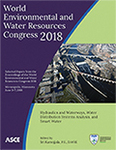World Environmental and Water Resources Congress 2018
Air Injection for Scour Reduction
Publication: World Environmental and Water Resources Congress 2018: Hydraulics and Waterways, Water Distribution Systems Analysis, and Smart Water
ABSTRACT
Scour at hydraulic structures such as bridge piers and abutments, stilling basins, and river bends can cause loss of life, structural collapse, and environmental damage to the ecosystem. Although many passive (requiring no greenhouse emitting use of electricity) scour countermeasures exist, such as riprap, submerged vanes, collars, spur dikes, sills, and sacrificial piles, these are subject to local scour and destruction themselves. An alternative flow-altering scour countermeasure consisting of air injection into the scour-inducing flow pattern can have benefits. Air injection cannot cause local scour due to the flow-adjusting nature of the bubbles since they are not rigid. Although injecting air does require an air compressor, it can be powered by solar panels and set up to only be activated during high-flows. Air injection is not needed in low-flows since the water velocity is slow and below the scour incipient motion conditions. Air injection has been proven successful in laboratory experiments for stilling basins and cylindrical bridge piers. Scour is reduced by the uplifting of the flow by the rising bubbles and the lowering of turbulence by the bubbles.
Get full access to this chapter
View all available purchase options and get full access to this chapter.
REFERENCES
Champagne, T. M. (2011). “Physical modeling of air injection as a scour remediation technique near gated weir stilling basins.” MS Thesis, Michigan Technological University, Houghton, MI. <https://digitalcommons.mtu.edu/cgi/viewcontent.cgi?article=1013&context=etd-restricted> (January 10, 2018).
Champagne, T. M., Barkdoll, B. D., Gonzalez-Castro, J. A., and Deaton, L. (2016a). “Scour Reduction by Air Injection: Flow Patterns and Turbulence.” Journal of Hydraulic Engineering, 142(3) - March 2016. https://doi.org/10.1061/(ASCE)HY.1943-7900.0001066
Champagne, T. M., Barlock, R. R., Ghimire, S. R., and Barkdoll, B. D. (2016b). “Scour Reduction by Air Injection Downstream of Stilling Basins: Optimal Configuration Determination by Experimentation.” Journal of Irrigation and Drainage Engineering, 142(12) - December 2016. https://doi.org/10.1061/(ASCE)IR.1943-4774.0001108
Chiew, Y.-M. (1992). "Scour Protection at Bridge Piers." Journal of Hydraulic Engineering 118(9): 1260–1269.
Chiew, Y.-M., and Lim, S.-Y. (2003). "Protection of bridge piers using a sacrificial sill." Water and Maritime Engineering. Institute of Civil Engineers. 53–62.
Dugue, V., Blanckaert, K., Chen, Q., and Schleiss, A. J. (2015). "Influencing Flow Patterns and Bed Morphology in Open Channels and Rivers by means of an Air-Bubble Screen." Journal of Hydraulic Engineering 141(2).
Grimaldi, C., Roberto, G., Francesco, C., and Cardoso, A. H. (2009). "Countermeasures against Local Scouring at Bridge Piers: Slot and Combined Sysytem of Slot and Bed Sill." Journal of Hydraulic Engineering (ASCE) 135 (5): 425–431.
Harrison, L. J. (1992). "Magnitude of The Scour Evaluation Program." Hydraulic Engineering: Saving a Threatened Resource - In Search of Solutions. Baltimore, MD: American Society of Civil Engineers.
Isbash, S. V. (1935). "Construction of Dams by Dumping Stones In Flowing Water" Translated byA. Dovjikov. Eastport, Maine: United States Engineer Office, Engineer Division.
Koloseus, H. J. (1984). "Scour Due to Riprap and Improper Filters." Journal of Hydraulic Engineering 110(10): 1315–1324.
Lagasse, P. F., Clopper, P. E., Zevenbergen, L. W., and Girard, L. G. (2007). Countermeasures to Protect Bridge Piers from Scour. National Cooperative Highway Research Program Report 593, Washington: Transportation Research Board.
Melvelle, B. W. and Coleman, S. E. (2000). “Bridge Scour.” Water Resources Publications, LLC, Highland Ranch, CO.
Melville, B. W., and Anna C. Hadfield. 1999. "Use of Sacrificial Piles as Pier Scour Countermeasures." Journal of Hydraulic Engineering 1221–1224.
Moncada-M, A. T., Aguire, J, Bolivar, J. C., and Flores, E. J. (2009). "Scour protection of circular piers with collars and slots." Journal of Hydraulic Research 119–126.
Parola, A. C. Jr, and Jones, J. S. (1991). "Sizing Riprap to Protect Bridge Piers from Scour." Transportation Research Record (1290), 276–280.
Tafarojnoruz, A., Gaudio, R., and Calomino, F. (2012). "Evaluation of Flow-Altering Countermeasures against Bridge Pier Scour." Journal of Hydraulic Engineering 297–305.
Tippireddy, R. T. R. (2017). “Air injection as a scour countermeasure at bridge piers.” MS Thesis, Michigan Technological University, Houghton, MI. <https://digitalcommons.mtu.edu/cgi/viewcontent.cgi?article=1512&context=etdr> (January 10, 2018).
Information & Authors
Information
Published In
World Environmental and Water Resources Congress 2018: Hydraulics and Waterways, Water Distribution Systems Analysis, and Smart Water
Pages: 75 - 81
Editor: Sri Kamojjala, Las Vegas Valley Water District
ISBN (Online): 978-0-7844-8142-4
Copyright
© 2018 American Society of Civil Engineers.
History
Published online: May 31, 2018
Authors
Metrics & Citations
Metrics
Citations
Download citation
If you have the appropriate software installed, you can download article citation data to the citation manager of your choice. Simply select your manager software from the list below and click Download.
